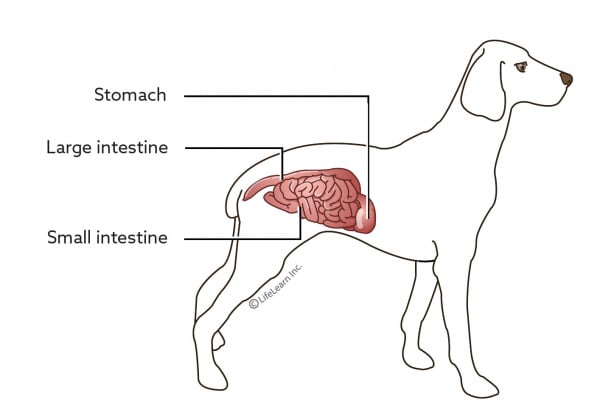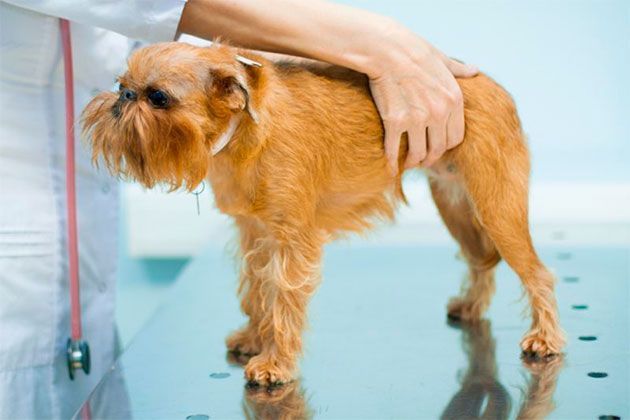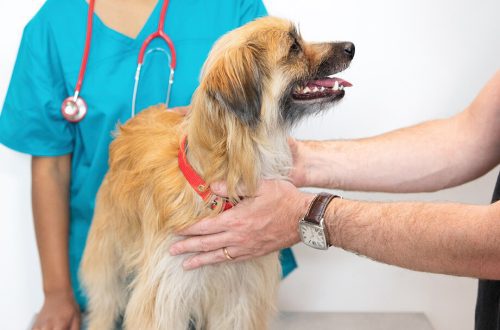
Enteritis dina anjing

What is enteritis? Hearing the word “enteritis”, many owners panic: “my dog is vaccinated!”. They mean at the same time infectious parvovirus enteritis. And they are often wrong. Enteritis is an inflammation of the small intestine. There can be many reasons for its occurrence and types of enteritis – we will talk about this in our article.
Daptar eusi
Types of enteritis
Main types: catarrhal, hemorrhagic. May be infectious or non-infectious. The greatest danger to the life of a pet is viral enteritis.
Nyababkeun enteritis
infectious nature:
- Parvovirus enteritis. Parvovirus, getting into the body, begins to multiply very quickly. The disease manifests itself in three forms – intestinal, cardiac and mixed, which usually occur at lightning speed, acutely, less often chronically. With a lightning-fast course of the intestinal form of the disease in puppies at the age of six to ten weeks, a breakdown is observed, then death occurs after a few hours. The incubation period of the acute intestinal form of the disease is five to six days. The first signs are anorexia, then mucous vomiting appears and 6-24 hours after the onset of vomiting – diarrhea. Feces are yellowish-gray or gray-green, green, purple, mixed with blood and mucus, watery, with a sharp fetid odor. The body temperature of sick animals rises to 39,5-41°. Animals quickly lose weight, the skin becomes dry, the coat dull, visible mucous membranes lose their luster, look reddened or anemic. In the acute form of the disease, death can occur in one to two days. The cardiac form of the disease is more common in puppies between the ages of one and two months. Note heart failure with frequent and weak pulse, pulmonary edema. The disease proceeds at lightning speed, with a fatal outcome of up to 80%. With the intestinal form of the disease, death in puppies is up to 50%, in adult dogs – up to 10%.
- Coronavirus enteritis. Coronavirus has a weaker effect and does not affect the heart muscle. However, in this case, without timely and proper treatment, the animal will die. It is characterized by hemorrhagic inflammation of the gastrointestinal tract, dehydration and general exhaustion of the body. Feces are offensive, yellowish-orange, watery, and may contain mucus and blood.
- hemorrhagic enteritis. The exact causes of this syndrome have not been determined, according to one theory, the disease is an intestinal type 1 hypersensitivity reaction to bacterial toxins or the bacteria themselves, according to another theory, the gastrointestinal tract lesion develops in response to the production of toxins by E. coli or Clostridium bacteria spp. Regardless of the cause, in canine hemorrhagic gastroenteritis, there is a significant increase in vascular and mucosal permeability, leading to a rapid loss of blood, protein, and fluid into the lumen of the gastrointestinal tract. The development of the disease is characterized by a hyperacute or acute onset, the animal usually comes to the reception in a state of severe depression and even shock. The main primary complaint when contacting a veterinary clinic is usually hemorrhagic diarrhea, the disease in most cases is accompanied by vomiting.
- Canine distemper virus. Depending on the severity of clinical signs, pulmonary, intestinal, nervous, skin, mixed and abortive forms of the disease are distinguished. The disease is accompanied by fever, inflammation of the mucous membranes of the eyes, respiratory organs and gastrointestinal tract, degenerative changes in the liver, kidneys, brain and spinal cord. Enteritis-like form – intestinal (gastrointestinal) – is manifested by serious lesions of the digestive system, including acute gastroenteritis, and is accompanied by food refusal, vomiting, as well as constipation and diarrhea, which leads to dehydration and rapid exhaustion of animals. Fecal masses contain mucus, often with an admixture of blood.
- Rotavirus. Most often, rotavirus infection is a form of intestinal infection. For this reason, in veterinary practice, an infectious disease caused by viruses of the rotavirus family is also called “intestinal”, “stomach flu”. The initial stage is a sharp rise in temperature, fever, chills, mild symptoms of gastroenteritis. A pet refuses food, favorite treats. During the day, diarrhea, frequent bouts of vomiting, and nausea are noted. Fecal masses acquire a fetid odor, green-yellow color. There is a lot of mucus in the feces, blood clots are possible. Vomiting, diarrhea lead to weakening, severe dehydration (dehydration) of the body. Dehydration can cause severe shock in a dog, causing death. The death of small puppies in the acute course of rotavirus infection occurs on the second or third day from the moment of infection.
Non-infectious nature:
- Parasitic, caused by helminths or protozoa.
- VZK. Complex of inflammatory bowel diseases.
- Diseases of the internal organs, for example, pancreatitis.
- Karacunan.
- Awak asing.
- Poor quality feed and malnutrition (for example, leftovers).
- Tumor dina saluran pencernaan.
Various symptoms may appear: diarrhea, including with mucus and blood, vomiting, depression, weakness, poor appetite or refusal to eat, intense thirst, rumbling in the abdomen, flatulence.
Cara pikeun mindahkeun
Non-infectious enteritis is dangerous only for a sick dog, for others it is not contagious. The situation is different with infectious types of enteritis. The main mode of infection is fecal-oral. That is, the virus enters the environment with feces, and then into the digestive tract of another dog with food, water, or through licking. Puppies are most susceptible to the disease, but unvaccinated adult dogs can also become seriously ill, even fatal.
gejala
It is difficult, and often impossible, to distinguish by symptoms which type of enteritis is encountered. The flow can be very similar. The main signs of enteritis and associated symptoms can be:
- Diarrhea. Moreover, it can be very different: with impurities, blood, mucus, a pungent odor, various shades.
- Utah.
- Fever in case of infection.
- Decreased appetite or complete refusal to feed.
- Lemes.
- Rapid onset dehydration due to vomiting, diarrhea, and fever.
If you notice these symptoms in your dog, contact your veterinarian immediately!
Diagnostics
One diagnostic method in case of enteritis is not enough. The approach will be comprehensive. We do not recommend trying to self-medicate at home. You can wait for the maximum in the hope that it will “pass by itself” if the dog had an unformed stool without blood 1-2 times and the condition is assessed as above satisfactory. Otherwise, a doctor’s examination is necessary. Tell the doctor all the details of the dog’s life, the onset of symptoms, whether you tried to treat yourself, whether the dog has recently picked up suspicious objects on the street, what he eats and what lifestyle he leads. The doctor will offer a plan of diagnostic measures that will help in making a diagnosis and finding out the cause:
- Express test for parvovirus enteritis.
- PCR diagnostics to exclude coronovirus, parvovirus and plague.
- Tes getih klinis.
- Biochemical blood test to exclude pathologies of internal organs.
- Abdominal ultrasound. With proper preparation, you can clearly visualize the walls and lumen of the gastrointestinal tract. Before the ultrasound, a twelve-hour fasting diet and giving drugs that reduce gas formation are required.
- X-ray. Sometimes it is necessary as a method of additional diagnostics.
- Fecal analysis for the detection of protozoa and helminths.
anggapanana
There is no specific antiviral treatment. Also, if the cause of enteritis cannot be established, therapy is prescribed to eliminate the symptoms that the animal has. Restoration of water and electrolyte balance by placing a venous catheter and droppers. Administration of antiemetic drugs by injection. Antibiotics are used to suppress the secondary microflora. Drugs are prescribed to reduce the intensity of symptomatic manifestations. These drugs include sedatives, painkillers, antispasmodics. With helminthiases and protozooses, tablets are used, the action of which destroys parasites. If the treatment of parvovirus enteritis in dogs is successful, the pet should have an interest in life and an appetite. Water can be given to animals. This will remove all toxic substances from the body. You can feed the animal only 12 hours after the appearance of appetite. It is better to use easily digestible food, diets for diseases of the gastrointestinal tract – at first in a mild form.
Complications caused by enteritis
The causative agent of parvovirus enteritis can lead to the death of a dog, especially young unvaccinated puppies recently weaned from their mother. Mortality can reach 90%. A complication can also be myocarditis – inflammation of the heart muscle, and often there is also a sudden death of puppies. Due to damage to the intestinal walls for a long time, food can be absorbed worse, overall immunity decreases.
ramalan
The prognosis for infectious enteritis is cautious to poor. With non-infectious, depending on the cause, with timely contact with the veterinary clinic, a favorable outcome of the disease.
pacegahan
Prevention of gastroenteritis is achieved by keeping animals in good conditions, sufficient exercise, balanced feeding. Vaccination is mandatory from 8 weeks of age, in case of a high risk of infection, puppies are vaccinated from 4 weeks. Adult dogs should be vaccinated annually. Parvovirus persists in the environment for about a year, so during this time, if you have a dead puppy or an infected dog, it is not recommended to have dogs for a year. The risk of infection in a vaccinated dog will be much less and it will tolerate the disease more easily, but we do not recommend taking risks. Either get rid of household items or sanitize them.





